
RI Coastal Resources Management Council
...to preserve, protect, develop, and restore coastal resources for all Rhode Islanders

...to preserve, protect, develop, and restore coastal resources for all Rhode Islanders
Coastweeks Events in October
Friday, October 4
Guided Marsh Walk
Caitlin Chaffee, coastal policy analyst for the R.I. Coastal Resources Management Council, and Wenley Ferguson, director of habitat restoration for Save The Bay, will lead this walking tour of the Rhode Island School of Design’s Barrington Beach salt marsh and describe the animals and plants that make this habitat home, as well as restoration efforts now underway. Pam Rubinoff, Rhode Island Sea Grant/URI Coastal Resources Center coastal management extension specialist, will join the team and describe how climate change and sea level rise are affecting coastal marshes, which serve as important buffer zones protecting upland areas.
This walk will meet at 11 a.m. at the Tillinghast Farm parking lot, 231 Nyatt Rd., Barrington. Participants should wear footwear appropriate for walking in wet and muddy areas. Those participants interested in helping Save The Bay do some of the digging that is part of the restoration work may choose to stay after the walk to volunteer. Shovels and gloves will be provided, but you should bring boots.
This walk is limited to 10 participants. Free. You must reserve your place in advance by contacting Laura Dwyer at (401) 783-7886 or ldwyer@crmc.ri.gov. The rain date for this event is Monday, October 7 at 3:30 p.m. Sponsored by the CRMC, Save the Bay, and Rhode Island Sea Grant.
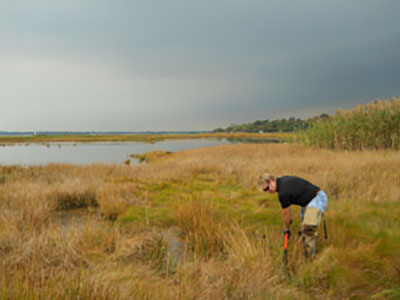
A Save The Bay volunteer digs mini-trenches to help flush the marsh at Rhode Island School of Design’s Barrington Beach salt marsh, which has been impounded by storm events, drowning the marsh in place.
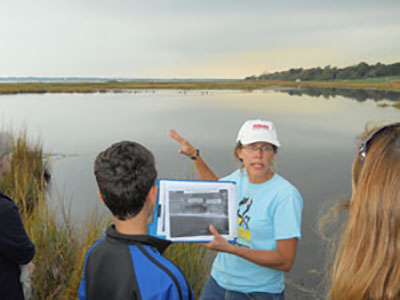
Wenley Ferguson, director of habitat restoration for Save The Bay, shows an aerial photo of the Barrington Beach salt marsh from 2012 showing the degree of impoundment to the marsh, and degradation caused by standing water.
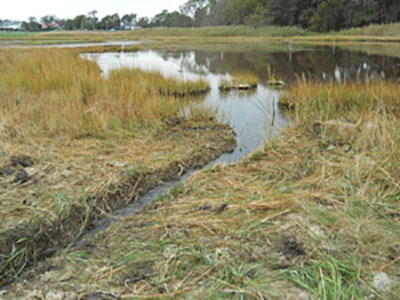
One of two small trenches Save The Bay volunteers dug in the Barrington Beach salt marsh will help to drain the area of the marsh that’s been flooded.
Saturday, October 5
Coastal Erosion Walking Tour
Take a walking tour of the south coast beaches with Janet Freedman, R.I. Coastal Resources Management Council coastal geologist and Michelle Carnevale, Rhode Island Sea Grant/ URI Coastal Resources Center coastal management extension specialist, and see first-hand the effects of coastal processes and how people deal with the challenges of living on the coastline. Participants will also learn what to expect in the future with changing climate conditions, and learn about what the CRMC is doing to help R.I. coastal communities plan for the future. The tour begins at South Kingstown Town Beach and continues to Card’s Pond.
10 a.m. to noon. Free, but advance reservations requested. Please contact Laura Dwyer at ldwyer@crmc.ri.gov or (401) 783-7886 to reserve your place. South Kingstown Town Beach, 719 Matunuck Beach Road. The rain date for this event is Saturday, October 12, at 10 a.m. Sponsored by the CRMC and the R.I. Shoreline Special Area Management Plan.
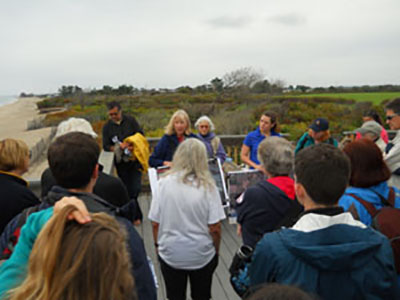
Janet Freedman shows the erosion walk attendees a soil profile, exposed by Sandy and recent storm events, as well as an illustration of the beach profile post-hurricane of 1938 and post-Sandy (they are almost identical).
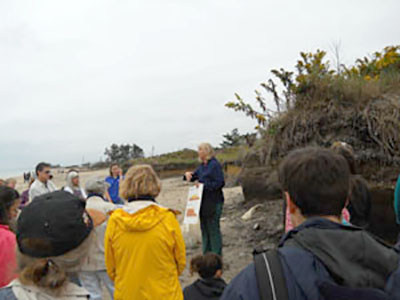
Janet Freedman shows the erosion walk attendees a soil profile, exposed by Sandy and recent storm events, as well as an illustration of the beach profile post-hurricane of 1938 and post-Sandy (they are almost identical).
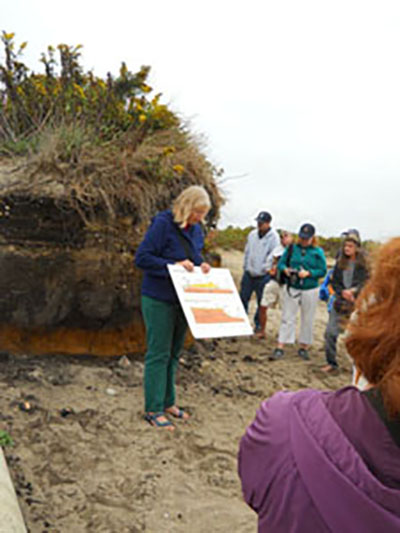
Janet Freedman, coastal geologist for the CRMC, and Michelle Carnevale, project manager for URI’s Coastal Resources Center, speak to a crowd about the effects of erosion and what the CRMC is doing to help the state’s coastal communities plan for the future.
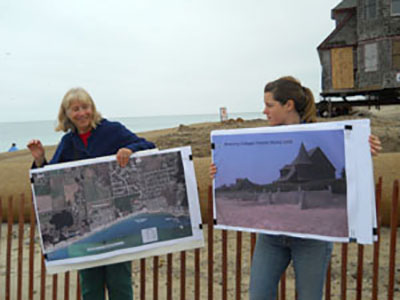
Janet and Michelle show pictures of the historic Browning Cottages, two of which were demolished after Sandy, and rates of shoreline change and erosion in the area on aerial maps. The red-trimmed house in the background is being elevated and moved away from the encroaching waves.
Monday, October 28
Marine Mammal Stranding Lecture
Whenever whales are found stranded on local beaches, marine animal stranding experts seek to find out the cause. Andrea Bogomolni, biologist and research associate at the Woods Hole Oceanographic Institution, will discuss how and why whales and other marine animals beach themselves.
4:30 p.m., Center for Biotechnology and Life Sciences, University of Rhode Island, Kingston, RI. This lecture is free. For directions and a campus map, please visit https://web.uri.edu/visit/maps-and-directions/bay-campus/. For more information, please contact Tracy Kennedy at (401) 874-6805 or tkennedy@mail.uri.edu. This lecture is part of the annual Community Lecture Series sponsored by Rhode Island Sea Grant, the URI Nutrition and Food Sciences Department, the URI College of the Environment and Life Sciences, and the R.I. Coastal Resources Management Council. The URI Marine Biology Program joins in the sponsorship of this lecture. Parking for this event is available at Fine Arts South Visitor Lot.